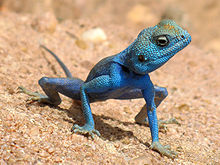Pseudotrapelus
| Sinai agama | |
|---|---|
 |
|
| Male | |
 |
|
| Female | |
| Scientific classification | |
| Kingdom: | Animalia |
| Phylum: | Chordata |
| Class: | Reptilia |
| Order: | Squamata |
| Suborder: | Iguania |
| Family: | Agamidae |
| Genus: | Pseudotrapelus |
| Species: | P. sinaitus |
| Binomial name | |
|
Pseudotrapelus sinaitus (Heyden, 1827 [originally Agama]) |
|
| Synonyms | |
The Sinai agama (Pseudotrapelus sinaitus, formerly Agama sinaita) is an agamid lizard found in arid areas of southeastern Libya, eastern Egypt,Palestine, Israel, Jordan, Syria, Saudi Arabia, the United Arab Emirates, Oman, eastern Sudan, Ethiopia, Eritrea, and Djibouti.
The length of the lizard including its long slender tail is 18 cm (7 in), the tail accounting for up to two-thirds of its total length. The limbs and tail are long and thin and allow for good climbing and running capability.
Pseudotrapelus sinaitus is active during daytime and feeds on insects and other arthropods and plants. During the breeding season, males become a striking blue colour to attract females. The female has brownish-red spots on her sides.
The Sinai agama is a small lizard with long legs, giving it an upright stance. It grows to a length of 18 cm (7 in) and has a long, slender tail, one and a half times as long as the body. The long head has the eyes fairly near the front with a distinctive pair of ear openings some way behind in line with the animal's mouth. The legs are long and slender and the tail is often held off the ground. This lizard is generally a dull brown colour, but during the breeding season, the male turns bright blue, or sometimes just the head and throat turn blue with the other parts remaining brown. Females and juveniles are greyish-brown all year round, but females often have a crescent-shaped red patch on each side just behind the forelimbs. The scales on the dorsal surface are relatively small, uniformly overlapping, and slightly keeled. The mid-back scales are slightly larger than elsewhere, and the scales on the tail are larger than those on the back. Unlike members of the closely related genus Agama, the third (middle) toe is the longest instead of the fourth.
...
Wikipedia
